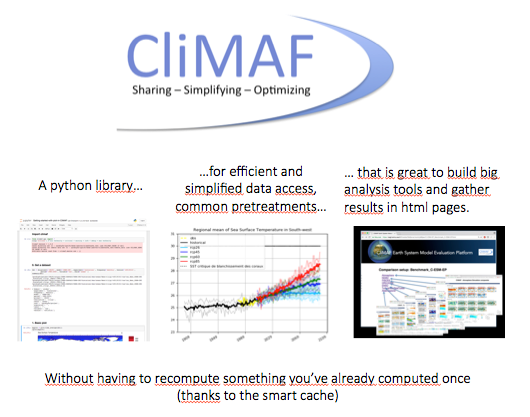Quick links : Subscribe to mailing list | News | Functions |
Standard operators and functions | HowTo… | Examples | Contents

Discover CliMAF: essentials of the documentation to get started
CliMAF - a Climate Model Assessment Framework
CliMAF is an Open Source software, distributed
with a GPL-compatible licence. See the licence notice.
It is available at CliMAF GitHub repository
The goal of CliMAF is to ease the common steps that separate you from your scientific diagnostic (in climate science):
CliMAF was designed to answer those specifications of CliMAF:
- We have several data organizations (path/filename syntax,
variable names, units… CMIP5 and CMIP6 at CLIMERI among
others) to deal with and we don’t want to rewrite all of
them
- We want to share diagnostics: one common library with a
vocabulary that follows standards (inspired by the CMIP
standards)
- We don’t want to exclude existing scripts: possibility to plug
any script that can be run with a command line, your own
post-processing and analysis scripts and programs as well as
other tools sets such as NCO and
CDO
operators
- We want to ease all those classic/basic treatments we do everyday: selection of a period, variable, geographical region, working on an ensemble
- We don’t want to recompute what has already been computed once
- We want to use this library to build a custom set of diagnostics as well as a big evaluation package like the CliMAF Earth System Model Evaluation Platform

Can CliMAF make my scientific life easier?
- You want to know what CliMAF is about? Here are some notebooks to illustrate interesting things to do with it:
-
- And to go further on data analysis:
-
The links point to the html versions of the notebooks.
You can get the original notebooks (.ipynb) in Examples.
Have a look at this documentation to see how to reuse a notebook from a python script (and avoid the conversion from the notebook to python script).
FAQ (Frequently Asked Questions)
TBD, with your feedbacks.
We need you for this! please send your questions at: climaf@meteo.fr
Another way to describe CliMAF
CliMAF is basically a Python-scriptable way to process NetCDF CF compliant climate model outputs which allows:
- to almost forget about accessing input data : you refer to
‘variables’ in ‘simulations’, CliMAF knows a bunch of data
organization schemes, you just quote some root locations, usually in
configuration files ; [ under development : data can also be on the
ESGF ]
- to apply diagnostics (i.e. any post-processing module) coded in
any langage, provided they meet very minimal requirements, such as
described in section Operators : using external scripts, binaries and python functions ; they can be :
- either binaries, which accepts command-line arguments, read NetCDF
files, and output NetCDF files or graphics (yet only in PNG format)
- or Python function which accept Masked Arrays data structure as inputs and outputs
- to easily pipe and combine such diagnostic binaries or functions
- to describe the piping using Python scripting, thus building formal
expressions in a simple syntax (called CRS for CliMAF Reference Syntax)
- to trigger CRS expression computation only once needed
- to handle a cache of results, which access keys are CRS expressions
A very low-profile knowledge of Python is enough to take full advantage of CliMAF
Content
See the full, extended table at Contents

